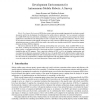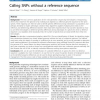6770 search results - page 1294 / 1354 » How GPUs Work |
AROBOTS
2007
13 years 7 months ago
2007
Robotic Development Environments (RDEs) have come to play an increasingly important role in robotics research in general, and for the development of architectures for mobile robot...
AROBOTS
2007
13 years 7 months ago
2007
— A central goal of robotics and AI is to be able to deploy an agent to act autonomously in the real world over an extended period of time. To operate in the real world, autonomo...
BIODATAMINING
2008
13 years 7 months ago
2008
During the past two decades, the field of human genetics has experienced an information explosion. The completion of the human genome project and the development of high throughpu...
BMCBI
2010
13 years 7 months ago
2010
Background: The most common application for the next-generation sequencing technologies is resequencing, where short reads from the genome of an individual are aligned to a refere...
BMCBI
2010
13 years 7 months ago
2010
Background: Epistatic miniarray profiling (E-MAPs) is a high-throughput approach capable of quantifying aggravating or alleviating genetic interactions between gene pairs. The dat...



